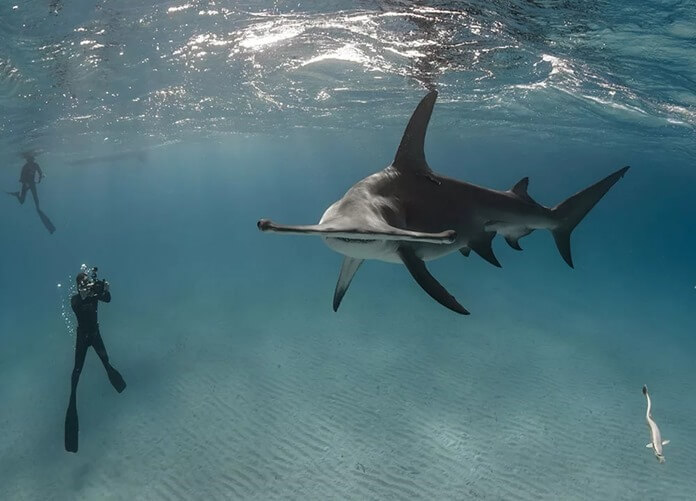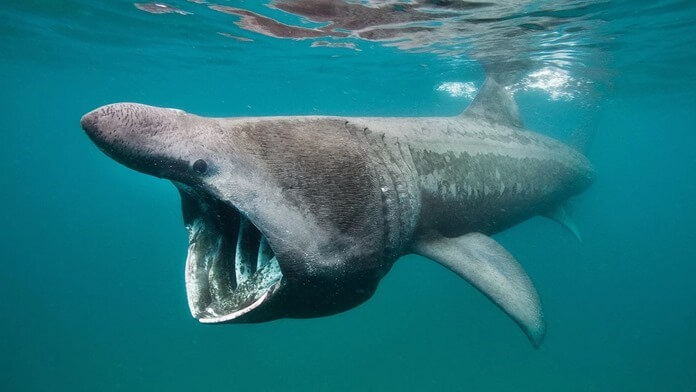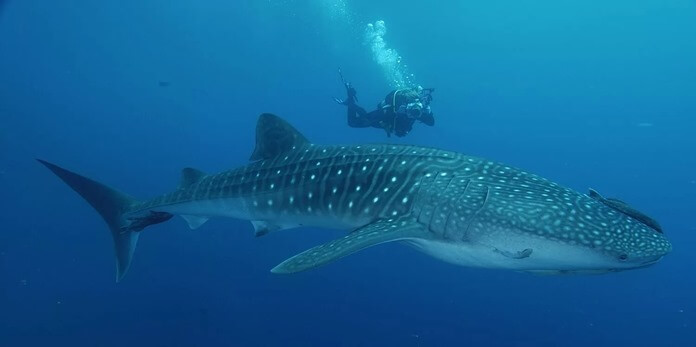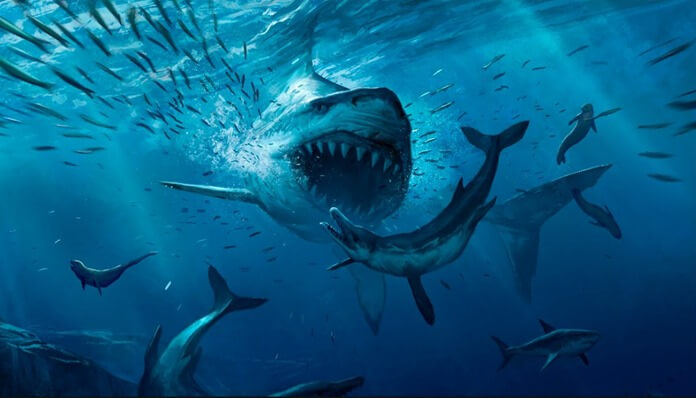Watch for the largest sharks in the world — very exciting. On TV, anyway. But if you're in their habitat, you become a potential food source for these ruthless underwater predators.
The good news: Most sharks, and there are 450 species, are not big enough to threaten you. The smallest shark is only 17 centimeters (6.7 inches). But there are bigger monsters in the deep sea. And for some of the biggest sharks, humans are just lunch.
Top 10 Largest Sharks in the World
10. Mako shark - up to 4.45 meters in length, weight - 280 kg
 The coloring of mako sharks is one of the characteristics that distinguishes them from most of their relatives. The dorsal part of these sharks can vary from a deep purple to a bright blue shade. The sides are silvery, and the belly is white.
The coloring of mako sharks is one of the characteristics that distinguishes them from most of their relatives. The dorsal part of these sharks can vary from a deep purple to a bright blue shade. The sides are silvery, and the belly is white.
The main enemies of mako sharks are people who eat their meat. Mako sharks themselves prefer dolphins, squid, mackerel, and sea turtles for lunch. They definitely have a variety of food preferences.
No shark in the world can swim as fast as the Mako shark. The speed and distances these creatures can swim are simply incredible. The Mako shark's constant speed is 35 km/h, and the fastest is 80 km/h.
9. Sixgill shark - 5.4 m, 590 kg
 These deep-sea predators are distinguished by the following features: they have six pairs of long gill slits on each side of their wide head, comb-like teeth on the lower jaw and a long tail.
These deep-sea predators are distinguished by the following features: they have six pairs of long gill slits on each side of their wide head, comb-like teeth on the lower jaw and a long tail.
Sixgill sharks inhabit continental and island shelves in temperate and tropical seas worldwide, in the Pacific, Atlantic and Indian Oceans.
The diet of these huge sharks includes other sharks, seahorses, many species of large bony fish, and invertebrates, including squid and crabs. This shark has also been known to eat dead animals such as seals and whales. As for interactions with humans, it seems that the predator simply tolerates the presence of bipeds in its territory. Divers regularly observe juvenile sixgill sharks off the Pacific coast of Canada. Sometimes they swim close to divers and even surfers, but without threatening actions or physical contact.
8. Tiger shark - 5.5 m, 1500 kg
 Perhaps even more dangerous than the great white, the tiger shark is known to prey on seabirds, dolphins, and other marine life. Often hunting near the shore, at depths of 6 and even 3 meters, tiger sharks can attack divers. Their attacks are more often fatal to humans than those of the great white. On average, there are 3-4 tiger shark attacks on humans per year.
Perhaps even more dangerous than the great white, the tiger shark is known to prey on seabirds, dolphins, and other marine life. Often hunting near the shore, at depths of 6 and even 3 meters, tiger sharks can attack divers. Their attacks are more often fatal to humans than those of the great white. On average, there are 3-4 tiger shark attacks on humans per year.
They got their name due to the stripes on their bodies, which resemble the coloring of a tiger's skin.
7. Megamouth shark - 5.7 m, 1500 kg
 The appearance of this shark with a huge mouth immediately brings to mind horror films, where the diver is waiting for a sad ending. However, do not be afraid, despite its appearance, the megamouth shark feeds on plankton.
The appearance of this shark with a huge mouth immediately brings to mind horror films, where the diver is waiting for a sad ending. However, do not be afraid, despite its appearance, the megamouth shark feeds on plankton.
Perhaps it was this species that inspired people to create legends about monsters that were half whales and half sharks.
Pelagic megamouth sharks are very rare and have no commercial value.
6. Thresher shark - 6.1 m, 500 kg
 The genus of thresher sharks (also known as sea foxes) includes three species. The largest of them is Alopias vulpinus. These predatory creatures prefer the open ocean, not visiting depths below 500 meters. In the photo, it is easy to see the most prominent part of the thresher shark - this is the long upper lobe of the tail fin. Sometimes it is equal in length to the entire body of the shark.
The genus of thresher sharks (also known as sea foxes) includes three species. The largest of them is Alopias vulpinus. These predatory creatures prefer the open ocean, not visiting depths below 500 meters. In the photo, it is easy to see the most prominent part of the thresher shark - this is the long upper lobe of the tail fin. Sometimes it is equal in length to the entire body of the shark.
Humans pose a much greater threat to thresher sharks than sharks do to humans. These creatures are hunted for their meat, skin, fins (used as a delicacy in soup) and liver.
When people appear nearby, sea foxes get scared and immediately swim away. Although some divers can be stunned by the shark's tail, which it uses as a whip.
5. Great hammerhead shark - 6.1 m, 454 kg
 Hammerhead sharks are very rarely encountered by people, as they are on the verge of extinction.
Hammerhead sharks are very rarely encountered by people, as they are on the verge of extinction.
This species of sharks is distinguished by beautiful fins and a special head shape - very flattened, with large outgrowths on the sides. These underwater inhabitants are clearly not among the most beautiful fish.
4. Greenland shark - 6.4 m, 1000 kg
 Although Greenland sharks are not usually aggressive, they are certainly among the largest sharks on the planet and should not be approached without good reason.
Although Greenland sharks are not usually aggressive, they are certainly among the largest sharks on the planet and should not be approached without good reason.
This shark's diet consists mainly of fish and marine mammals, and because of its slow movement, it usually poses no danger to humans. However, there are stories of Greenland sharks attacking kayaks.
3. Great White Shark - 6.4 m, 1900 kg
 Although it is not the largest shark on the list, it is known as one of the most dangerous animals and the largest predatory fish on Earth. The average adult size is 4.4-4.6 meters, and the body weight reaches 520-770 kg. But there is a lot of (unconfirmed) information about great white sharks. According to it, the largest great white shark can reach up to 10 meters in length.
Although it is not the largest shark on the list, it is known as one of the most dangerous animals and the largest predatory fish on Earth. The average adult size is 4.4-4.6 meters, and the body weight reaches 520-770 kg. But there is a lot of (unconfirmed) information about great white sharks. According to it, the largest great white shark can reach up to 10 meters in length.
It is difficult to measure how big a great white shark actually is. There are three reasons for this:
- These predators live in water, and approaching them is not entirely safe, to put it mildly.
- Another problem is their incredible speed: great white sharks can reach speeds of up to 56 km/h.
- The third difficulty is that white sharks' bodies are made mostly of water, so when they are on land, they dry out and become smaller in size.
It was the great white shark that featured as the antagonist in the cult film Jaws.
2. Basking shark - 9.8 m, 4000 kg
 Despite its scary name, this is a harmless creature. It feeds not on divers or even smaller relatives, but on plankton (tiny animals that can be found near the surface of the water) and small fish.
Despite its scary name, this is a harmless creature. It feeds not on divers or even smaller relatives, but on plankton (tiny animals that can be found near the surface of the water) and small fish.
Their mouths are huge; they can be over 1 meter wide. It would be logical to assume that a shark of this size would have long, sharp teeth, similar to those of a great white or tiger shark. However, a basking shark only has a few rows of small teeth. The large size of their mouths and the small size of their teeth directly correspond to the shark's unexpected diet. In order to feed, basking sharks keep their mouths open while they swim. This is how they collect plankton from the water.
Basking sharks are thermophilic and prefer moderately warm and warm waters. In addition, they prefer to swim close to the shore, near the surface, for which they have earned the nickname "sunfish".
1. Great Whale Shark - 20 m, 34,000 kg
 This is the largest living shark in the world. Luckily for most marine life – and us! – the whale shark’s favorite food is plankton. It doesn’t have the sharp teeth of smaller sharks, but it does have a huge number of them, up to 15,000. To eat, the shark opens its heavy jaws and passively filters everything in its path using a special filtering apparatus formed by its gill arches.
This is the largest living shark in the world. Luckily for most marine life – and us! – the whale shark’s favorite food is plankton. It doesn’t have the sharp teeth of smaller sharks, but it does have a huge number of them, up to 15,000. To eat, the shark opens its heavy jaws and passively filters everything in its path using a special filtering apparatus formed by its gill arches.
Preferring warm waters, whale sharks inhabit all tropical seas of our planet. They migrate each spring to the continental shelf of the central west coast of Australia, where they find an abundant supply of plankton.
Despite their enormous size, whale sharks are fairly calm and harmless fish. There is even a video on Twitter of a group of divers riding a whale shark.
The largest shark in history is 15-18 meters long, weighing 47 tons
 To the question of what is the largest shark in the world, science currently gives a confident answer - a large whale shark. But it was not always so.
To the question of what is the largest shark in the world, science currently gives a confident answer - a large whale shark. But it was not always so.
About 20 million years ago, a predator appeared in the world that is still the subject of films and books. Its name is megalodon (Otodus megalodon, formerly known as Carcharodon or Carcharocles megalodon). For 13 million years, the huge shark dominated other life in the oceans until it became extinct just 2.6 million years ago, during a global cooling.
Scientists believe that the largest megalodon specimens grew to 18 meters in length. For comparison: the length of the largest snake in the world reaches 14.8 meters.
 Estimates of the megalodon's body size are based on the size of the animal's teeth, which can reach 18 cm in length. In fact, the word megalodon simply means "big tooth." Interestingly, megalodon teeth have been found on every continent except Antarctica.
Estimates of the megalodon's body size are based on the size of the animal's teeth, which can reach 18 cm in length. In fact, the word megalodon simply means "big tooth." Interestingly, megalodon teeth have been found on every continent except Antarctica.
This giant shark fed on whales and large fish, and possibly other sharks. Its jaws, measuring 2.7 by 3.4 meters, were large enough to swallow two adults side by side.
The bite force of a human is about 1,317 newtons (N), the bite force of a great white shark is 18,211N. The bite force of a megalodon ranged from 108,514 to 182,201N.
What did megalodon look like?
 Most reconstructions show megalodon as looking like a great white shark. But scientists say that's wrong.
Most reconstructions show megalodon as looking like a great white shark. But scientists say that's wrong.
Megalodon probably had a much shorter nose than the great white shark, and a more flattened jaw. It had very long pectoral fins to support its enormous weight and size.
And the ancestor of the modern great white shark lived alongside the megalodon. Some shark researchers believe that they may have even competed with each other.
Could megalodon exist today?
If an animal the size of a megalodon still lived in the oceans, scientists would know about it.
Sharks leave their telltale bite marks on other large marine animals, and their huge teeth continue to litter the ocean floors. Not to mention that, being a heat-loving creature, megalodon will not be able to survive in the cold deep waters, where it has a better chance of remaining undetected.














Оставить Комментарий